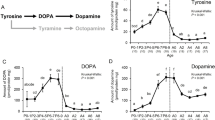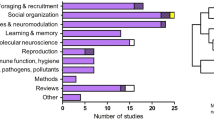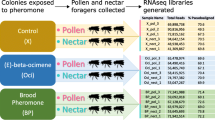Abstract.
Forager honey bees have higher brain levels of octopamine than do bees tending larvae in the hive. To test the hypothesis that octopamine influences honey bee division of labor we treated bees orally with octopamine or its immediate precursor tyramine and determined whether these treatments increased the probability of initiating foraging. Octopamine treatment significantly elevated levels of octopamine in the brain and caused a significant dose-dependent increase in the number of new foragers. This effect was seen for precocious foragers in single-cohort colonies and foragers in larger colonies with more typical age demographies. Tyramine treatment did not increase the number of new foragers, suggesting that octopamine was exerting a specific effect. Octopamine treatment was effective only when given to bees old enough to forage, i.e., older than 4 days of age. Treatment when bees were 1–3 days of age did not cause a significant increase in the number of new foragers when the bees reached the minimal foraging age. These results demonstrate that octopamine influences division of labor in honey bee colonies. We speculate that octopamine is acting in this context as a neuromodulator.
Similar content being viewed by others
Author information
Authors and Affiliations
Additional information
Electronic Publication
Rights and permissions
About this article
Cite this article
Schulz, D., Robinson, G. Octopamine influences division of labor in honey bee colonies. J Comp Physiol A 187, 53–61 (2001). https://doi.org/10.1007/s003590000177
Accepted:
Issue Date:
DOI: https://doi.org/10.1007/s003590000177




